Critical Analysis of Organizational Culture and Leadership
VerifiedAdded on 2023/06/03
|11
|2837
|494
Report
AI Summary
This report offers a comprehensive critical analysis of organizational culture and leadership, drawing upon several academic articles to explore their interconnectedness and influence on organizational effectiveness. The analysis begins by defining organizational culture and its impact on employee behavior, highlighting the role of social information processes in shaping cultural aspects. The report then delves into the relationship between organizational culture, leadership styles, and productivity, examining how these factors contribute to innovation and employee engagement. The analysis also explores the complexities arising from the interdependence of organizational culture and leadership, emphasizing the importance of communication and employee understanding within the organizational structure. Furthermore, the report discusses the practical implications for managers, emphasizing the significance of clear communication, leadership styles, and fostering a positive organizational culture to enhance productivity, innovation, and employee well-being. The report concludes with a summary of the key findings and insights from the analyzed articles, along with practical implications for managers in contemporary business environments.
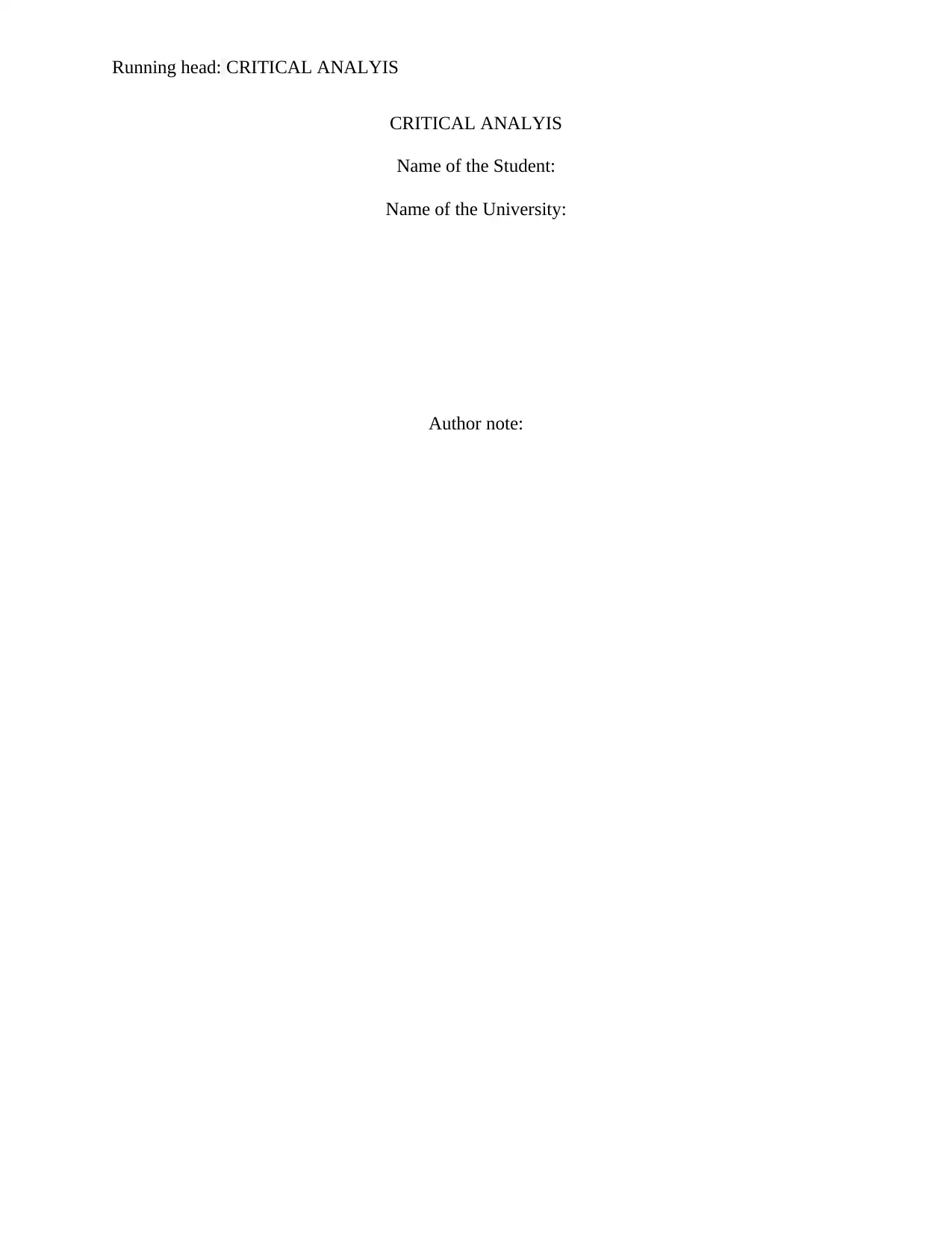
Running head: CRITICAL ANALYIS
CRITICAL ANALYIS
Name of the Student:
Name of the University:
Author note:
CRITICAL ANALYIS
Name of the Student:
Name of the University:
Author note:
Paraphrase This Document
Need a fresh take? Get an instant paraphrase of this document with our AI Paraphraser
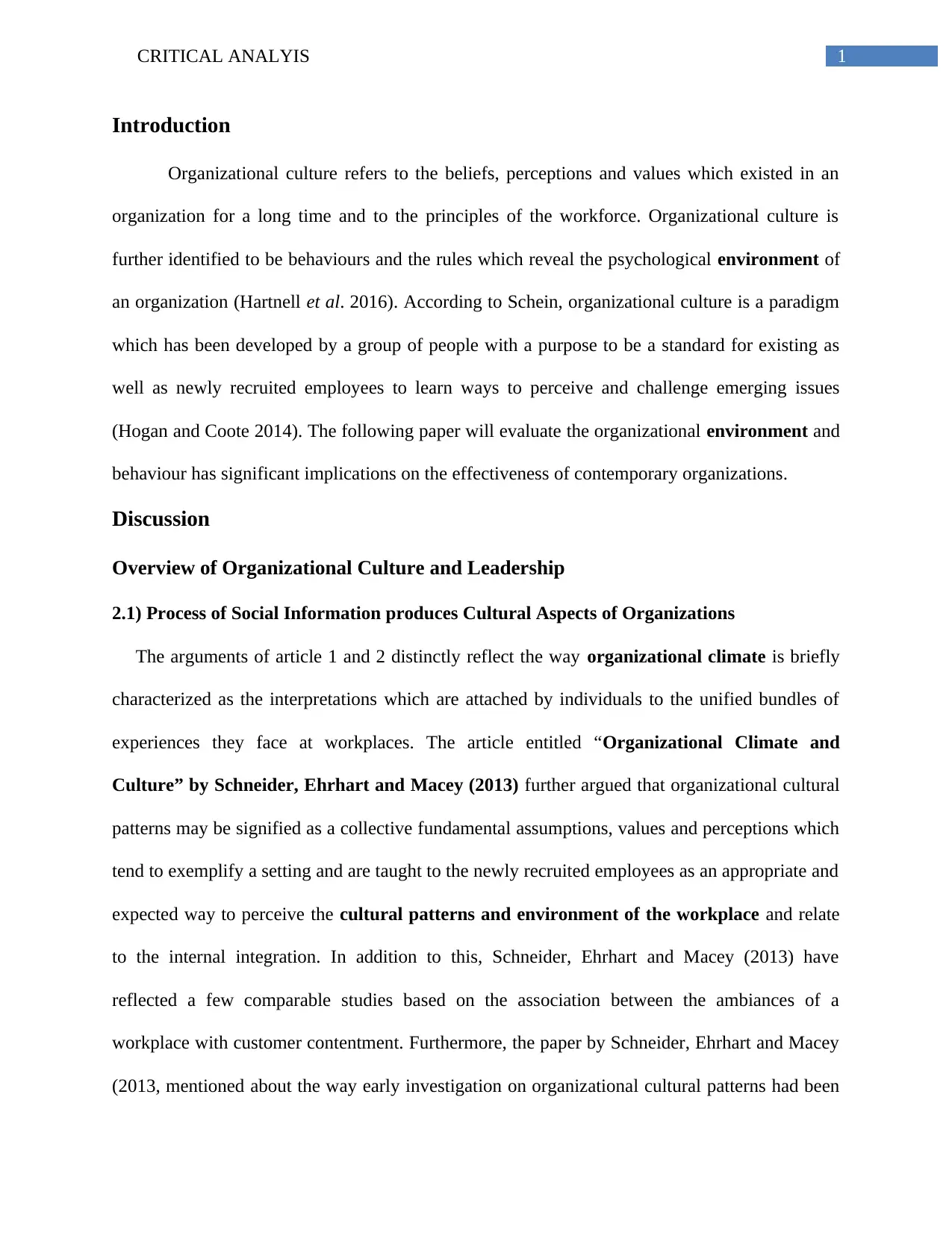
1CRITICAL ANALYIS
Introduction
Organizational culture refers to the beliefs, perceptions and values which existed in an
organization for a long time and to the principles of the workforce. Organizational culture is
further identified to be behaviours and the rules which reveal the psychological environment of
an organization (Hartnell et al. 2016). According to Schein, organizational culture is a paradigm
which has been developed by a group of people with a purpose to be a standard for existing as
well as newly recruited employees to learn ways to perceive and challenge emerging issues
(Hogan and Coote 2014). The following paper will evaluate the organizational environment and
behaviour has significant implications on the effectiveness of contemporary organizations.
Discussion
Overview of Organizational Culture and Leadership
2.1) Process of Social Information produces Cultural Aspects of Organizations
The arguments of article 1 and 2 distinctly reflect the way organizational climate is briefly
characterized as the interpretations which are attached by individuals to the unified bundles of
experiences they face at workplaces. The article entitled “Organizational Climate and
Culture” by Schneider, Ehrhart and Macey (2013) further argued that organizational cultural
patterns may be signified as a collective fundamental assumptions, values and perceptions which
tend to exemplify a setting and are taught to the newly recruited employees as an appropriate and
expected way to perceive the cultural patterns and environment of the workplace and relate
to the internal integration. In addition to this, Schneider, Ehrhart and Macey (2013) have
reflected a few comparable studies based on the association between the ambiances of a
workplace with customer contentment. Furthermore, the paper by Schneider, Ehrhart and Macey
(2013, mentioned about the way early investigation on organizational cultural patterns had been
Introduction
Organizational culture refers to the beliefs, perceptions and values which existed in an
organization for a long time and to the principles of the workforce. Organizational culture is
further identified to be behaviours and the rules which reveal the psychological environment of
an organization (Hartnell et al. 2016). According to Schein, organizational culture is a paradigm
which has been developed by a group of people with a purpose to be a standard for existing as
well as newly recruited employees to learn ways to perceive and challenge emerging issues
(Hogan and Coote 2014). The following paper will evaluate the organizational environment and
behaviour has significant implications on the effectiveness of contemporary organizations.
Discussion
Overview of Organizational Culture and Leadership
2.1) Process of Social Information produces Cultural Aspects of Organizations
The arguments of article 1 and 2 distinctly reflect the way organizational climate is briefly
characterized as the interpretations which are attached by individuals to the unified bundles of
experiences they face at workplaces. The article entitled “Organizational Climate and
Culture” by Schneider, Ehrhart and Macey (2013) further argued that organizational cultural
patterns may be signified as a collective fundamental assumptions, values and perceptions which
tend to exemplify a setting and are taught to the newly recruited employees as an appropriate and
expected way to perceive the cultural patterns and environment of the workplace and relate
to the internal integration. In addition to this, Schneider, Ehrhart and Macey (2013) have
reflected a few comparable studies based on the association between the ambiances of a
workplace with customer contentment. Furthermore, the paper by Schneider, Ehrhart and Macey
(2013, mentioned about the way early investigation on organizational cultural patterns had been
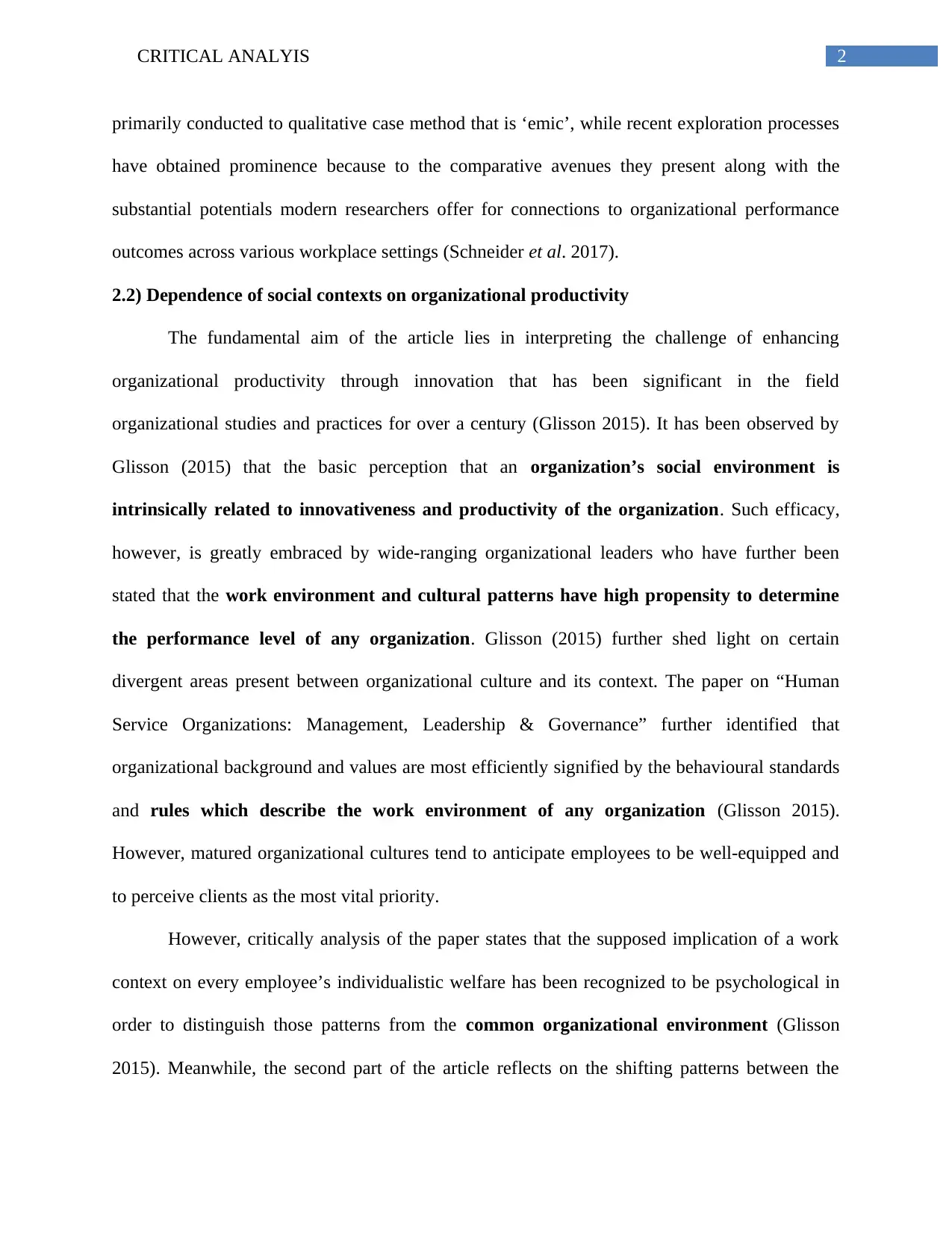
2CRITICAL ANALYIS
primarily conducted to qualitative case method that is ‘emic’, while recent exploration processes
have obtained prominence because to the comparative avenues they present along with the
substantial potentials modern researchers offer for connections to organizational performance
outcomes across various workplace settings (Schneider et al. 2017).
2.2) Dependence of social contexts on organizational productivity
The fundamental aim of the article lies in interpreting the challenge of enhancing
organizational productivity through innovation that has been significant in the field
organizational studies and practices for over a century (Glisson 2015). It has been observed by
Glisson (2015) that the basic perception that an organization’s social environment is
intrinsically related to innovativeness and productivity of the organization. Such efficacy,
however, is greatly embraced by wide-ranging organizational leaders who have further been
stated that the work environment and cultural patterns have high propensity to determine
the performance level of any organization. Glisson (2015) further shed light on certain
divergent areas present between organizational culture and its context. The paper on “Human
Service Organizations: Management, Leadership & Governance” further identified that
organizational background and values are most efficiently signified by the behavioural standards
and rules which describe the work environment of any organization (Glisson 2015).
However, matured organizational cultures tend to anticipate employees to be well-equipped and
to perceive clients as the most vital priority.
However, critically analysis of the paper states that the supposed implication of a work
context on every employee’s individualistic welfare has been recognized to be psychological in
order to distinguish those patterns from the common organizational environment (Glisson
2015). Meanwhile, the second part of the article reflects on the shifting patterns between the
primarily conducted to qualitative case method that is ‘emic’, while recent exploration processes
have obtained prominence because to the comparative avenues they present along with the
substantial potentials modern researchers offer for connections to organizational performance
outcomes across various workplace settings (Schneider et al. 2017).
2.2) Dependence of social contexts on organizational productivity
The fundamental aim of the article lies in interpreting the challenge of enhancing
organizational productivity through innovation that has been significant in the field
organizational studies and practices for over a century (Glisson 2015). It has been observed by
Glisson (2015) that the basic perception that an organization’s social environment is
intrinsically related to innovativeness and productivity of the organization. Such efficacy,
however, is greatly embraced by wide-ranging organizational leaders who have further been
stated that the work environment and cultural patterns have high propensity to determine
the performance level of any organization. Glisson (2015) further shed light on certain
divergent areas present between organizational culture and its context. The paper on “Human
Service Organizations: Management, Leadership & Governance” further identified that
organizational background and values are most efficiently signified by the behavioural standards
and rules which describe the work environment of any organization (Glisson 2015).
However, matured organizational cultures tend to anticipate employees to be well-equipped and
to perceive clients as the most vital priority.
However, critically analysis of the paper states that the supposed implication of a work
context on every employee’s individualistic welfare has been recognized to be psychological in
order to distinguish those patterns from the common organizational environment (Glisson
2015). Meanwhile, the second part of the article reflects on the shifting patterns between the
⊘ This is a preview!⊘
Do you want full access?
Subscribe today to unlock all pages.

Trusted by 1+ million students worldwide
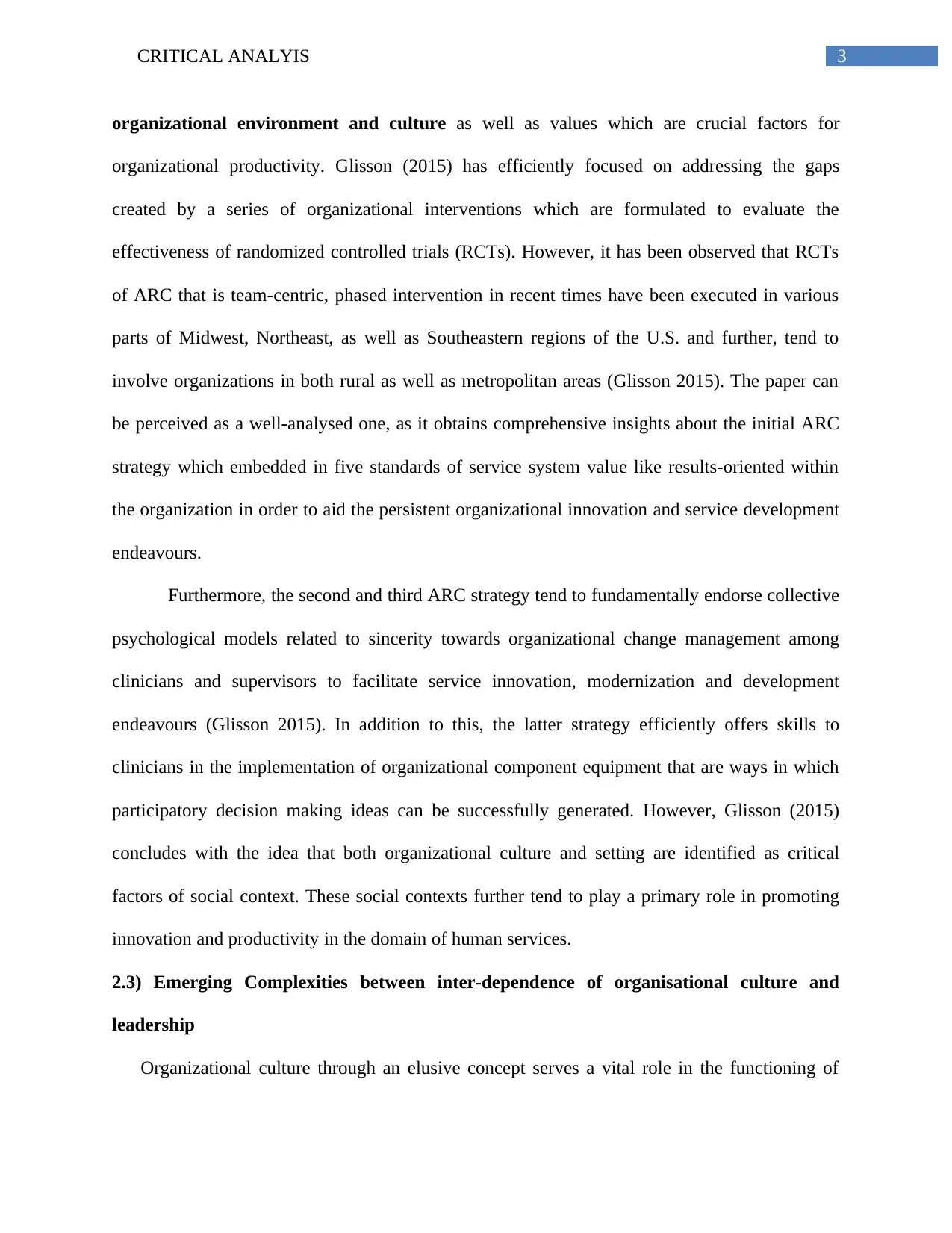
3CRITICAL ANALYIS
organizational environment and culture as well as values which are crucial factors for
organizational productivity. Glisson (2015) has efficiently focused on addressing the gaps
created by a series of organizational interventions which are formulated to evaluate the
effectiveness of randomized controlled trials (RCTs). However, it has been observed that RCTs
of ARC that is team-centric, phased intervention in recent times have been executed in various
parts of Midwest, Northeast, as well as Southeastern regions of the U.S. and further, tend to
involve organizations in both rural as well as metropolitan areas (Glisson 2015). The paper can
be perceived as a well-analysed one, as it obtains comprehensive insights about the initial ARC
strategy which embedded in five standards of service system value like results-oriented within
the organization in order to aid the persistent organizational innovation and service development
endeavours.
Furthermore, the second and third ARC strategy tend to fundamentally endorse collective
psychological models related to sincerity towards organizational change management among
clinicians and supervisors to facilitate service innovation, modernization and development
endeavours (Glisson 2015). In addition to this, the latter strategy efficiently offers skills to
clinicians in the implementation of organizational component equipment that are ways in which
participatory decision making ideas can be successfully generated. However, Glisson (2015)
concludes with the idea that both organizational culture and setting are identified as critical
factors of social context. These social contexts further tend to play a primary role in promoting
innovation and productivity in the domain of human services.
2.3) Emerging Complexities between inter-dependence of organisational culture and
leadership
Organizational culture through an elusive concept serves a vital role in the functioning of
organizational environment and culture as well as values which are crucial factors for
organizational productivity. Glisson (2015) has efficiently focused on addressing the gaps
created by a series of organizational interventions which are formulated to evaluate the
effectiveness of randomized controlled trials (RCTs). However, it has been observed that RCTs
of ARC that is team-centric, phased intervention in recent times have been executed in various
parts of Midwest, Northeast, as well as Southeastern regions of the U.S. and further, tend to
involve organizations in both rural as well as metropolitan areas (Glisson 2015). The paper can
be perceived as a well-analysed one, as it obtains comprehensive insights about the initial ARC
strategy which embedded in five standards of service system value like results-oriented within
the organization in order to aid the persistent organizational innovation and service development
endeavours.
Furthermore, the second and third ARC strategy tend to fundamentally endorse collective
psychological models related to sincerity towards organizational change management among
clinicians and supervisors to facilitate service innovation, modernization and development
endeavours (Glisson 2015). In addition to this, the latter strategy efficiently offers skills to
clinicians in the implementation of organizational component equipment that are ways in which
participatory decision making ideas can be successfully generated. However, Glisson (2015)
concludes with the idea that both organizational culture and setting are identified as critical
factors of social context. These social contexts further tend to play a primary role in promoting
innovation and productivity in the domain of human services.
2.3) Emerging Complexities between inter-dependence of organisational culture and
leadership
Organizational culture through an elusive concept serves a vital role in the functioning of
Paraphrase This Document
Need a fresh take? Get an instant paraphrase of this document with our AI Paraphraser
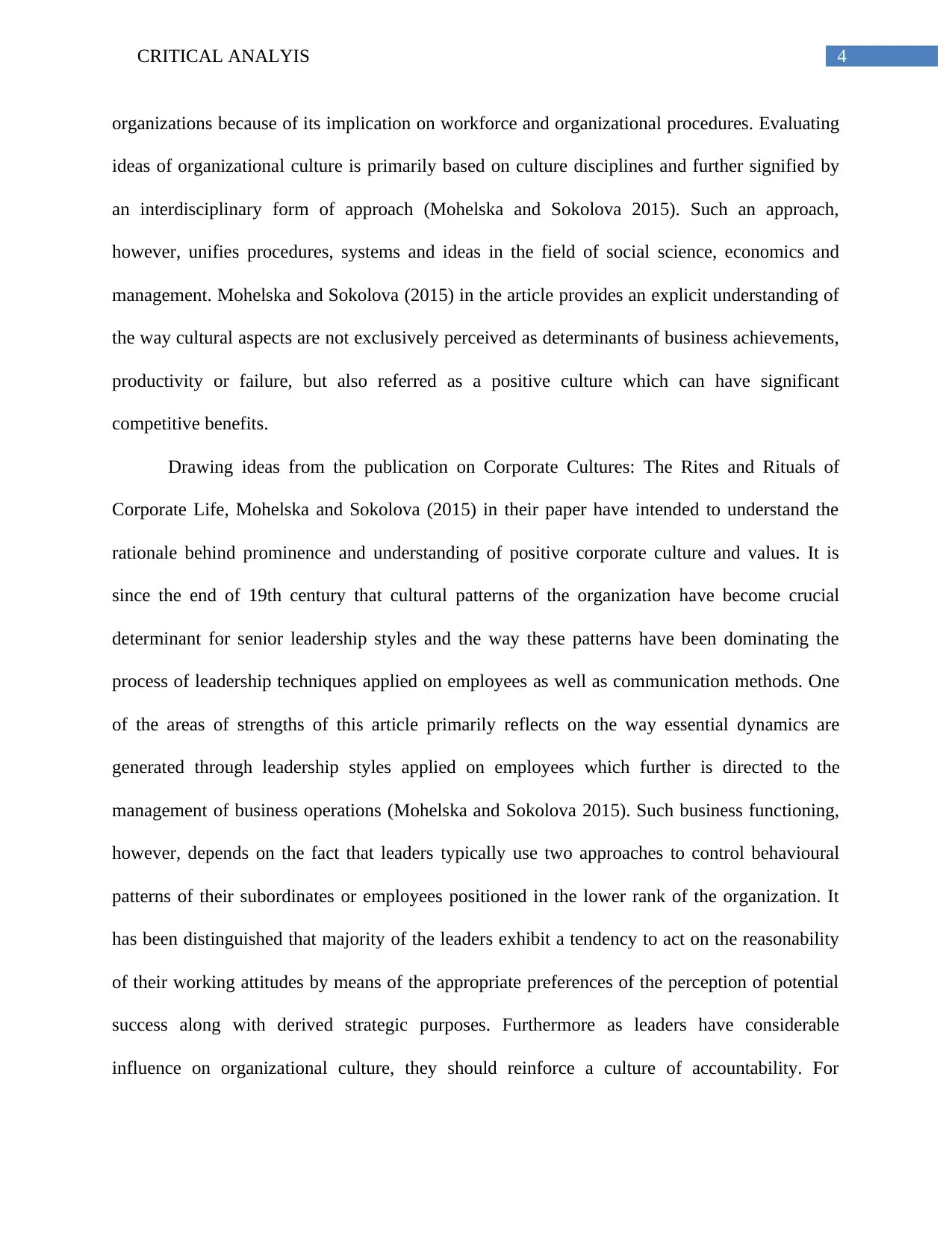
4CRITICAL ANALYIS
organizations because of its implication on workforce and organizational procedures. Evaluating
ideas of organizational culture is primarily based on culture disciplines and further signified by
an interdisciplinary form of approach (Mohelska and Sokolova 2015). Such an approach,
however, unifies procedures, systems and ideas in the field of social science, economics and
management. Mohelska and Sokolova (2015) in the article provides an explicit understanding of
the way cultural aspects are not exclusively perceived as determinants of business achievements,
productivity or failure, but also referred as a positive culture which can have significant
competitive benefits.
Drawing ideas from the publication on Corporate Cultures: The Rites and Rituals of
Corporate Life, Mohelska and Sokolova (2015) in their paper have intended to understand the
rationale behind prominence and understanding of positive corporate culture and values. It is
since the end of 19th century that cultural patterns of the organization have become crucial
determinant for senior leadership styles and the way these patterns have been dominating the
process of leadership techniques applied on employees as well as communication methods. One
of the areas of strengths of this article primarily reflects on the way essential dynamics are
generated through leadership styles applied on employees which further is directed to the
management of business operations (Mohelska and Sokolova 2015). Such business functioning,
however, depends on the fact that leaders typically use two approaches to control behavioural
patterns of their subordinates or employees positioned in the lower rank of the organization. It
has been distinguished that majority of the leaders exhibit a tendency to act on the reasonability
of their working attitudes by means of the appropriate preferences of the perception of potential
success along with derived strategic purposes. Furthermore as leaders have considerable
influence on organizational culture, they should reinforce a culture of accountability. For
organizations because of its implication on workforce and organizational procedures. Evaluating
ideas of organizational culture is primarily based on culture disciplines and further signified by
an interdisciplinary form of approach (Mohelska and Sokolova 2015). Such an approach,
however, unifies procedures, systems and ideas in the field of social science, economics and
management. Mohelska and Sokolova (2015) in the article provides an explicit understanding of
the way cultural aspects are not exclusively perceived as determinants of business achievements,
productivity or failure, but also referred as a positive culture which can have significant
competitive benefits.
Drawing ideas from the publication on Corporate Cultures: The Rites and Rituals of
Corporate Life, Mohelska and Sokolova (2015) in their paper have intended to understand the
rationale behind prominence and understanding of positive corporate culture and values. It is
since the end of 19th century that cultural patterns of the organization have become crucial
determinant for senior leadership styles and the way these patterns have been dominating the
process of leadership techniques applied on employees as well as communication methods. One
of the areas of strengths of this article primarily reflects on the way essential dynamics are
generated through leadership styles applied on employees which further is directed to the
management of business operations (Mohelska and Sokolova 2015). Such business functioning,
however, depends on the fact that leaders typically use two approaches to control behavioural
patterns of their subordinates or employees positioned in the lower rank of the organization. It
has been distinguished that majority of the leaders exhibit a tendency to act on the reasonability
of their working attitudes by means of the appropriate preferences of the perception of potential
success along with derived strategic purposes. Furthermore as leaders have considerable
influence on organizational culture, they should reinforce a culture of accountability. For
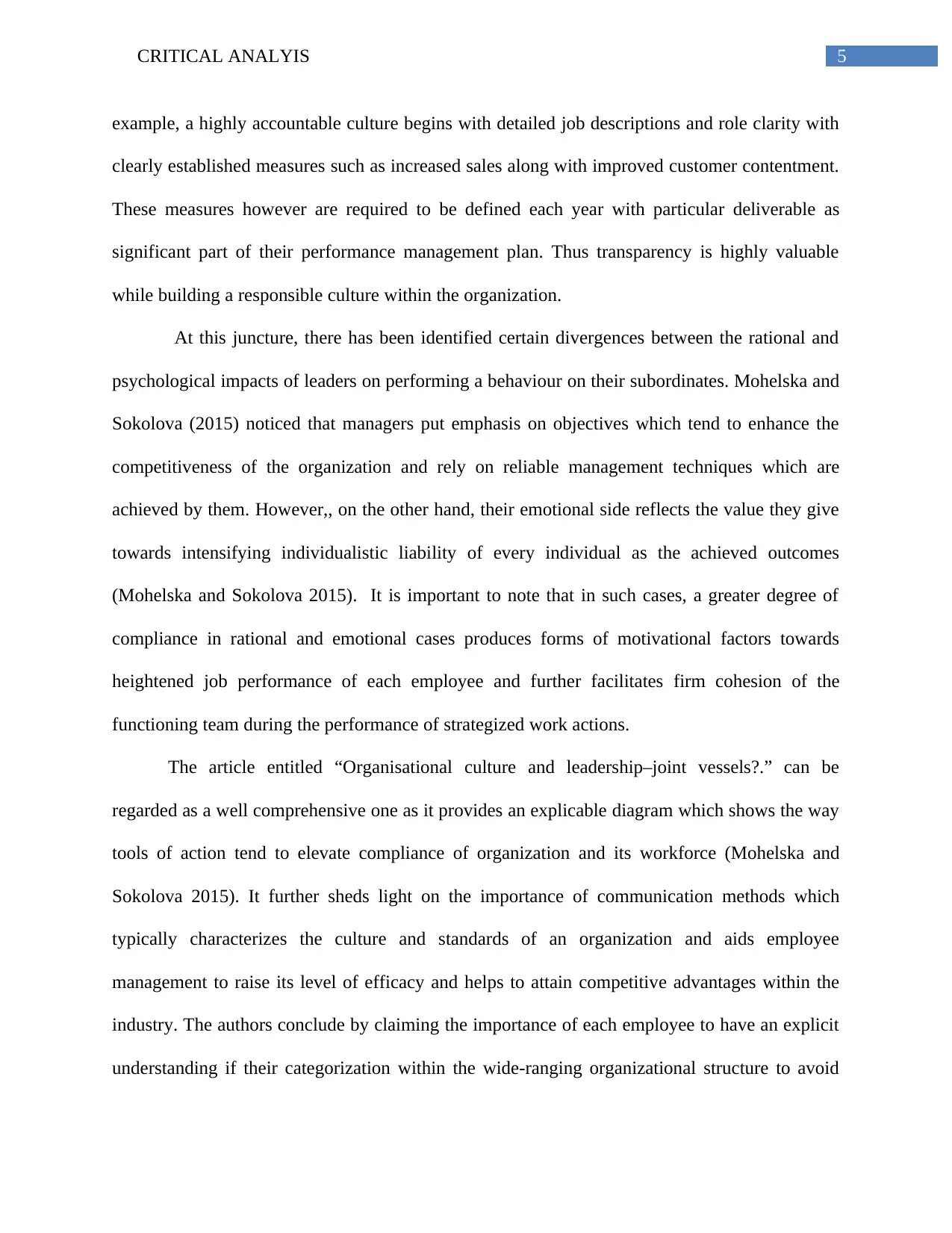
5CRITICAL ANALYIS
example, a highly accountable culture begins with detailed job descriptions and role clarity with
clearly established measures such as increased sales along with improved customer contentment.
These measures however are required to be defined each year with particular deliverable as
significant part of their performance management plan. Thus transparency is highly valuable
while building a responsible culture within the organization.
At this juncture, there has been identified certain divergences between the rational and
psychological impacts of leaders on performing a behaviour on their subordinates. Mohelska and
Sokolova (2015) noticed that managers put emphasis on objectives which tend to enhance the
competitiveness of the organization and rely on reliable management techniques which are
achieved by them. However,, on the other hand, their emotional side reflects the value they give
towards intensifying individualistic liability of every individual as the achieved outcomes
(Mohelska and Sokolova 2015). It is important to note that in such cases, a greater degree of
compliance in rational and emotional cases produces forms of motivational factors towards
heightened job performance of each employee and further facilitates firm cohesion of the
functioning team during the performance of strategized work actions.
The article entitled “Organisational culture and leadership–joint vessels?.” can be
regarded as a well comprehensive one as it provides an explicable diagram which shows the way
tools of action tend to elevate compliance of organization and its workforce (Mohelska and
Sokolova 2015). It further sheds light on the importance of communication methods which
typically characterizes the culture and standards of an organization and aids employee
management to raise its level of efficacy and helps to attain competitive advantages within the
industry. The authors conclude by claiming the importance of each employee to have an explicit
understanding if their categorization within the wide-ranging organizational structure to avoid
example, a highly accountable culture begins with detailed job descriptions and role clarity with
clearly established measures such as increased sales along with improved customer contentment.
These measures however are required to be defined each year with particular deliverable as
significant part of their performance management plan. Thus transparency is highly valuable
while building a responsible culture within the organization.
At this juncture, there has been identified certain divergences between the rational and
psychological impacts of leaders on performing a behaviour on their subordinates. Mohelska and
Sokolova (2015) noticed that managers put emphasis on objectives which tend to enhance the
competitiveness of the organization and rely on reliable management techniques which are
achieved by them. However,, on the other hand, their emotional side reflects the value they give
towards intensifying individualistic liability of every individual as the achieved outcomes
(Mohelska and Sokolova 2015). It is important to note that in such cases, a greater degree of
compliance in rational and emotional cases produces forms of motivational factors towards
heightened job performance of each employee and further facilitates firm cohesion of the
functioning team during the performance of strategized work actions.
The article entitled “Organisational culture and leadership–joint vessels?.” can be
regarded as a well comprehensive one as it provides an explicable diagram which shows the way
tools of action tend to elevate compliance of organization and its workforce (Mohelska and
Sokolova 2015). It further sheds light on the importance of communication methods which
typically characterizes the culture and standards of an organization and aids employee
management to raise its level of efficacy and helps to attain competitive advantages within the
industry. The authors conclude by claiming the importance of each employee to have an explicit
understanding if their categorization within the wide-ranging organizational structure to avoid
⊘ This is a preview!⊘
Do you want full access?
Subscribe today to unlock all pages.

Trusted by 1+ million students worldwide
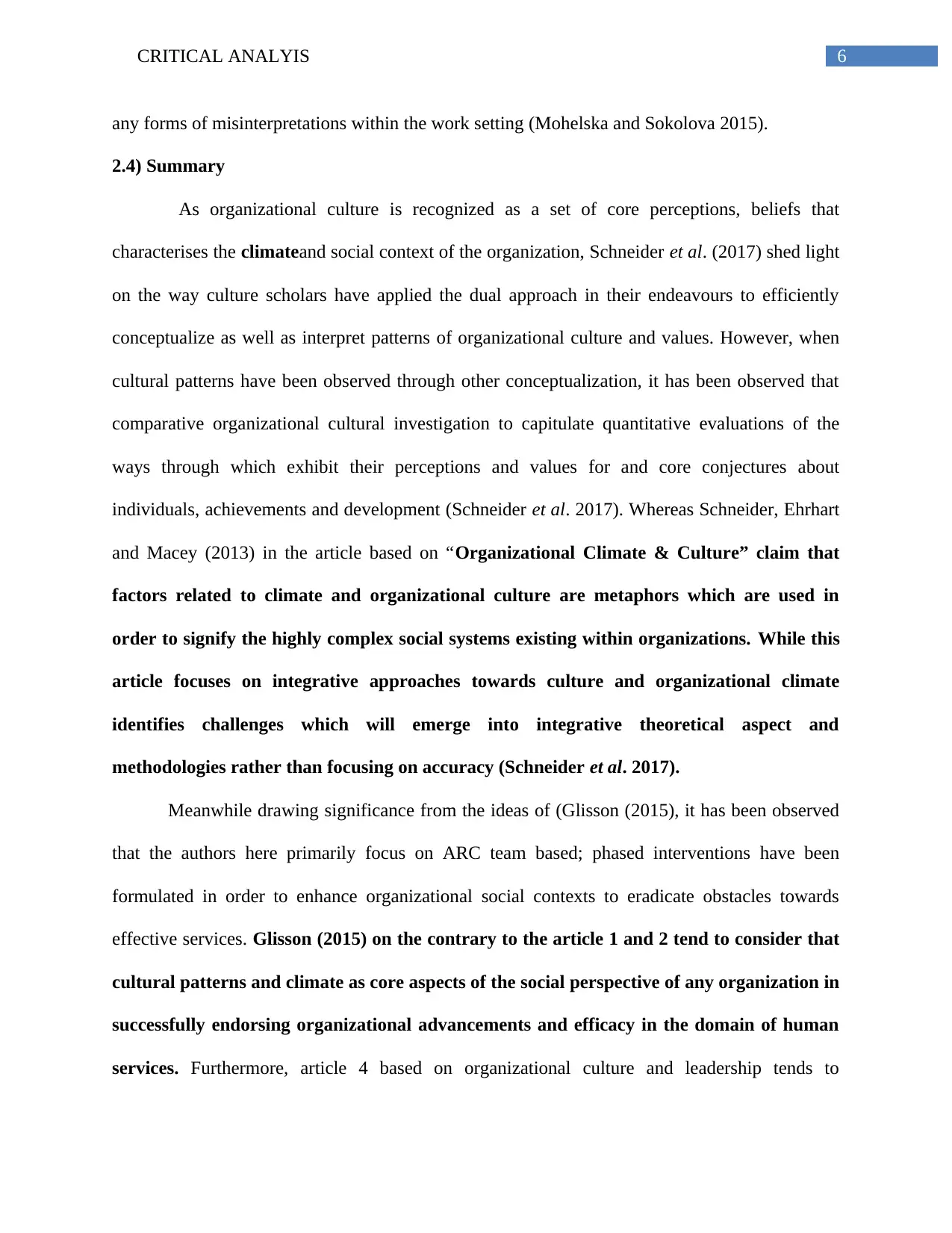
6CRITICAL ANALYIS
any forms of misinterpretations within the work setting (Mohelska and Sokolova 2015).
2.4) Summary
As organizational culture is recognized as a set of core perceptions, beliefs that
characterises the climateand social context of the organization, Schneider et al. (2017) shed light
on the way culture scholars have applied the dual approach in their endeavours to efficiently
conceptualize as well as interpret patterns of organizational culture and values. However, when
cultural patterns have been observed through other conceptualization, it has been observed that
comparative organizational cultural investigation to capitulate quantitative evaluations of the
ways through which exhibit their perceptions and values for and core conjectures about
individuals, achievements and development (Schneider et al. 2017). Whereas Schneider, Ehrhart
and Macey (2013) in the article based on “Organizational Climate & Culture” claim that
factors related to climate and organizational culture are metaphors which are used in
order to signify the highly complex social systems existing within organizations. While this
article focuses on integrative approaches towards culture and organizational climate
identifies challenges which will emerge into integrative theoretical aspect and
methodologies rather than focusing on accuracy (Schneider et al. 2017).
Meanwhile drawing significance from the ideas of (Glisson (2015), it has been observed
that the authors here primarily focus on ARC team based; phased interventions have been
formulated in order to enhance organizational social contexts to eradicate obstacles towards
effective services. Glisson (2015) on the contrary to the article 1 and 2 tend to consider that
cultural patterns and climate as core aspects of the social perspective of any organization in
successfully endorsing organizational advancements and efficacy in the domain of human
services. Furthermore, article 4 based on organizational culture and leadership tends to
any forms of misinterpretations within the work setting (Mohelska and Sokolova 2015).
2.4) Summary
As organizational culture is recognized as a set of core perceptions, beliefs that
characterises the climateand social context of the organization, Schneider et al. (2017) shed light
on the way culture scholars have applied the dual approach in their endeavours to efficiently
conceptualize as well as interpret patterns of organizational culture and values. However, when
cultural patterns have been observed through other conceptualization, it has been observed that
comparative organizational cultural investigation to capitulate quantitative evaluations of the
ways through which exhibit their perceptions and values for and core conjectures about
individuals, achievements and development (Schneider et al. 2017). Whereas Schneider, Ehrhart
and Macey (2013) in the article based on “Organizational Climate & Culture” claim that
factors related to climate and organizational culture are metaphors which are used in
order to signify the highly complex social systems existing within organizations. While this
article focuses on integrative approaches towards culture and organizational climate
identifies challenges which will emerge into integrative theoretical aspect and
methodologies rather than focusing on accuracy (Schneider et al. 2017).
Meanwhile drawing significance from the ideas of (Glisson (2015), it has been observed
that the authors here primarily focus on ARC team based; phased interventions have been
formulated in order to enhance organizational social contexts to eradicate obstacles towards
effective services. Glisson (2015) on the contrary to the article 1 and 2 tend to consider that
cultural patterns and climate as core aspects of the social perspective of any organization in
successfully endorsing organizational advancements and efficacy in the domain of human
services. Furthermore, article 4 based on organizational culture and leadership tends to
Paraphrase This Document
Need a fresh take? Get an instant paraphrase of this document with our AI Paraphraser
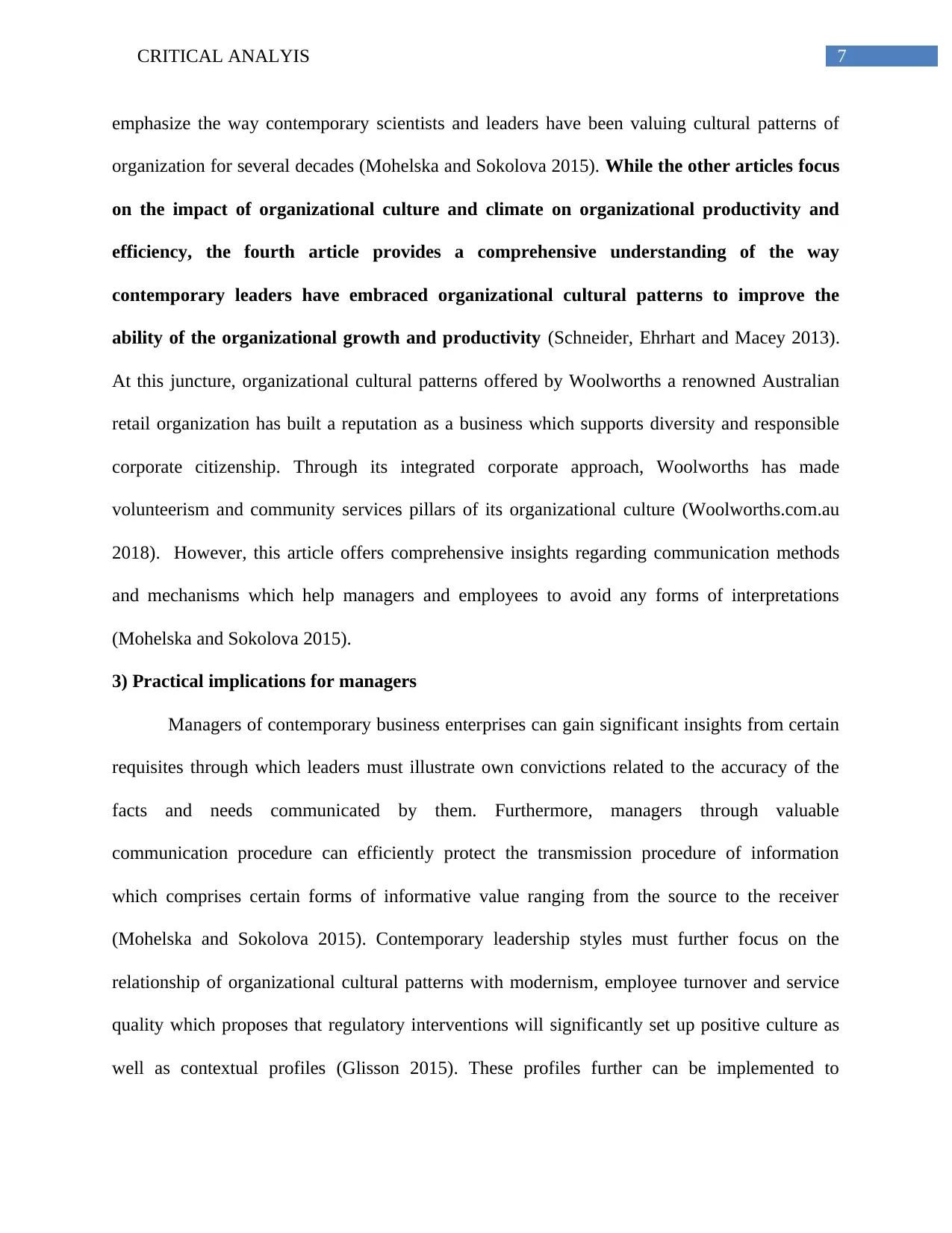
7CRITICAL ANALYIS
emphasize the way contemporary scientists and leaders have been valuing cultural patterns of
organization for several decades (Mohelska and Sokolova 2015). While the other articles focus
on the impact of organizational culture and climate on organizational productivity and
efficiency, the fourth article provides a comprehensive understanding of the way
contemporary leaders have embraced organizational cultural patterns to improve the
ability of the organizational growth and productivity (Schneider, Ehrhart and Macey 2013).
At this juncture, organizational cultural patterns offered by Woolworths a renowned Australian
retail organization has built a reputation as a business which supports diversity and responsible
corporate citizenship. Through its integrated corporate approach, Woolworths has made
volunteerism and community services pillars of its organizational culture (Woolworths.com.au
2018). However, this article offers comprehensive insights regarding communication methods
and mechanisms which help managers and employees to avoid any forms of interpretations
(Mohelska and Sokolova 2015).
3) Practical implications for managers
Managers of contemporary business enterprises can gain significant insights from certain
requisites through which leaders must illustrate own convictions related to the accuracy of the
facts and needs communicated by them. Furthermore, managers through valuable
communication procedure can efficiently protect the transmission procedure of information
which comprises certain forms of informative value ranging from the source to the receiver
(Mohelska and Sokolova 2015). Contemporary leadership styles must further focus on the
relationship of organizational cultural patterns with modernism, employee turnover and service
quality which proposes that regulatory interventions will significantly set up positive culture as
well as contextual profiles (Glisson 2015). These profiles further can be implemented to
emphasize the way contemporary scientists and leaders have been valuing cultural patterns of
organization for several decades (Mohelska and Sokolova 2015). While the other articles focus
on the impact of organizational culture and climate on organizational productivity and
efficiency, the fourth article provides a comprehensive understanding of the way
contemporary leaders have embraced organizational cultural patterns to improve the
ability of the organizational growth and productivity (Schneider, Ehrhart and Macey 2013).
At this juncture, organizational cultural patterns offered by Woolworths a renowned Australian
retail organization has built a reputation as a business which supports diversity and responsible
corporate citizenship. Through its integrated corporate approach, Woolworths has made
volunteerism and community services pillars of its organizational culture (Woolworths.com.au
2018). However, this article offers comprehensive insights regarding communication methods
and mechanisms which help managers and employees to avoid any forms of interpretations
(Mohelska and Sokolova 2015).
3) Practical implications for managers
Managers of contemporary business enterprises can gain significant insights from certain
requisites through which leaders must illustrate own convictions related to the accuracy of the
facts and needs communicated by them. Furthermore, managers through valuable
communication procedure can efficiently protect the transmission procedure of information
which comprises certain forms of informative value ranging from the source to the receiver
(Mohelska and Sokolova 2015). Contemporary leadership styles must further focus on the
relationship of organizational cultural patterns with modernism, employee turnover and service
quality which proposes that regulatory interventions will significantly set up positive culture as
well as contextual profiles (Glisson 2015). These profiles further can be implemented to
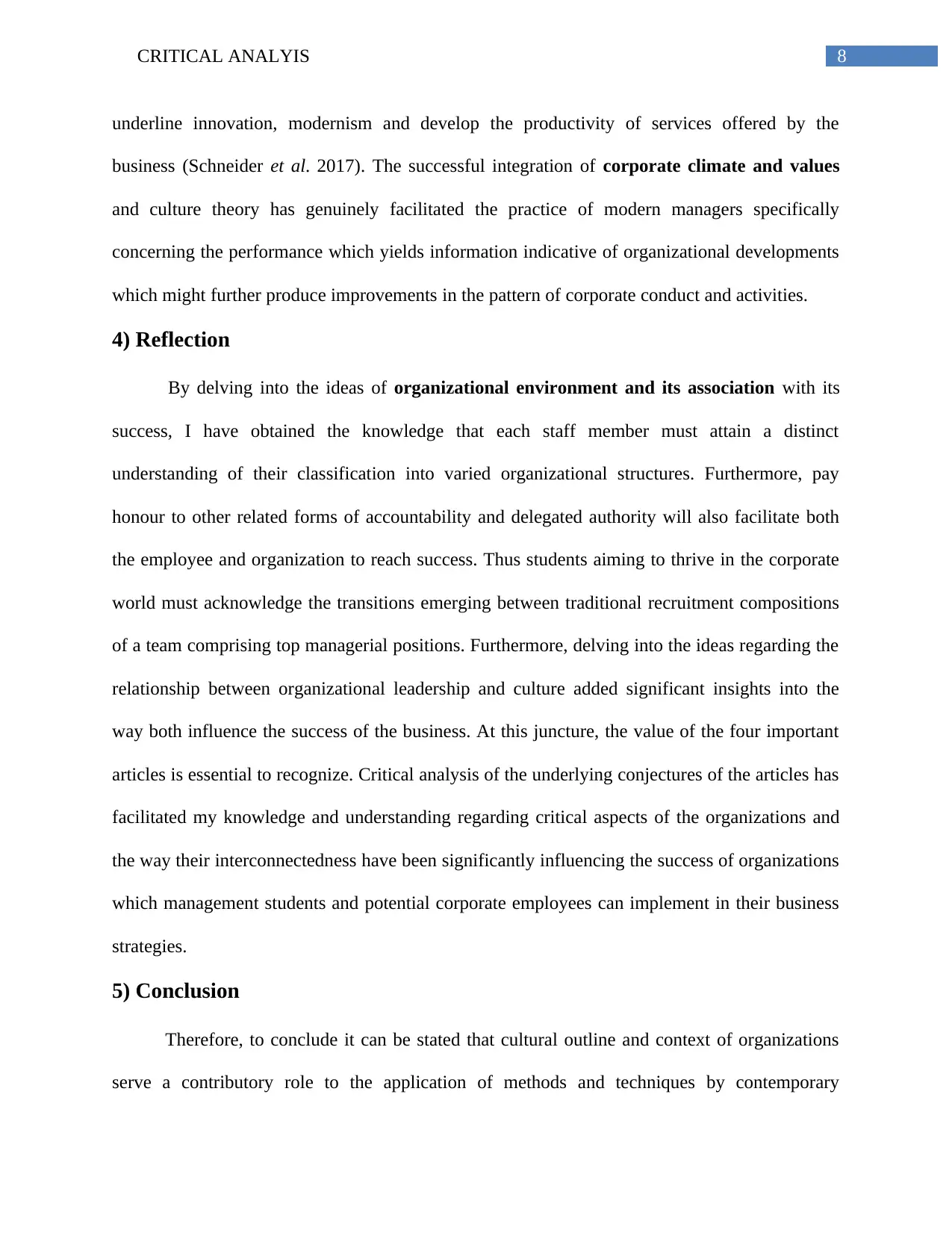
8CRITICAL ANALYIS
underline innovation, modernism and develop the productivity of services offered by the
business (Schneider et al. 2017). The successful integration of corporate climate and values
and culture theory has genuinely facilitated the practice of modern managers specifically
concerning the performance which yields information indicative of organizational developments
which might further produce improvements in the pattern of corporate conduct and activities.
4) Reflection
By delving into the ideas of organizational environment and its association with its
success, I have obtained the knowledge that each staff member must attain a distinct
understanding of their classification into varied organizational structures. Furthermore, pay
honour to other related forms of accountability and delegated authority will also facilitate both
the employee and organization to reach success. Thus students aiming to thrive in the corporate
world must acknowledge the transitions emerging between traditional recruitment compositions
of a team comprising top managerial positions. Furthermore, delving into the ideas regarding the
relationship between organizational leadership and culture added significant insights into the
way both influence the success of the business. At this juncture, the value of the four important
articles is essential to recognize. Critical analysis of the underlying conjectures of the articles has
facilitated my knowledge and understanding regarding critical aspects of the organizations and
the way their interconnectedness have been significantly influencing the success of organizations
which management students and potential corporate employees can implement in their business
strategies.
5) Conclusion
Therefore, to conclude it can be stated that cultural outline and context of organizations
serve a contributory role to the application of methods and techniques by contemporary
underline innovation, modernism and develop the productivity of services offered by the
business (Schneider et al. 2017). The successful integration of corporate climate and values
and culture theory has genuinely facilitated the practice of modern managers specifically
concerning the performance which yields information indicative of organizational developments
which might further produce improvements in the pattern of corporate conduct and activities.
4) Reflection
By delving into the ideas of organizational environment and its association with its
success, I have obtained the knowledge that each staff member must attain a distinct
understanding of their classification into varied organizational structures. Furthermore, pay
honour to other related forms of accountability and delegated authority will also facilitate both
the employee and organization to reach success. Thus students aiming to thrive in the corporate
world must acknowledge the transitions emerging between traditional recruitment compositions
of a team comprising top managerial positions. Furthermore, delving into the ideas regarding the
relationship between organizational leadership and culture added significant insights into the
way both influence the success of the business. At this juncture, the value of the four important
articles is essential to recognize. Critical analysis of the underlying conjectures of the articles has
facilitated my knowledge and understanding regarding critical aspects of the organizations and
the way their interconnectedness have been significantly influencing the success of organizations
which management students and potential corporate employees can implement in their business
strategies.
5) Conclusion
Therefore, to conclude it can be stated that cultural outline and context of organizations
serve a contributory role to the application of methods and techniques by contemporary
⊘ This is a preview!⊘
Do you want full access?
Subscribe today to unlock all pages.

Trusted by 1+ million students worldwide
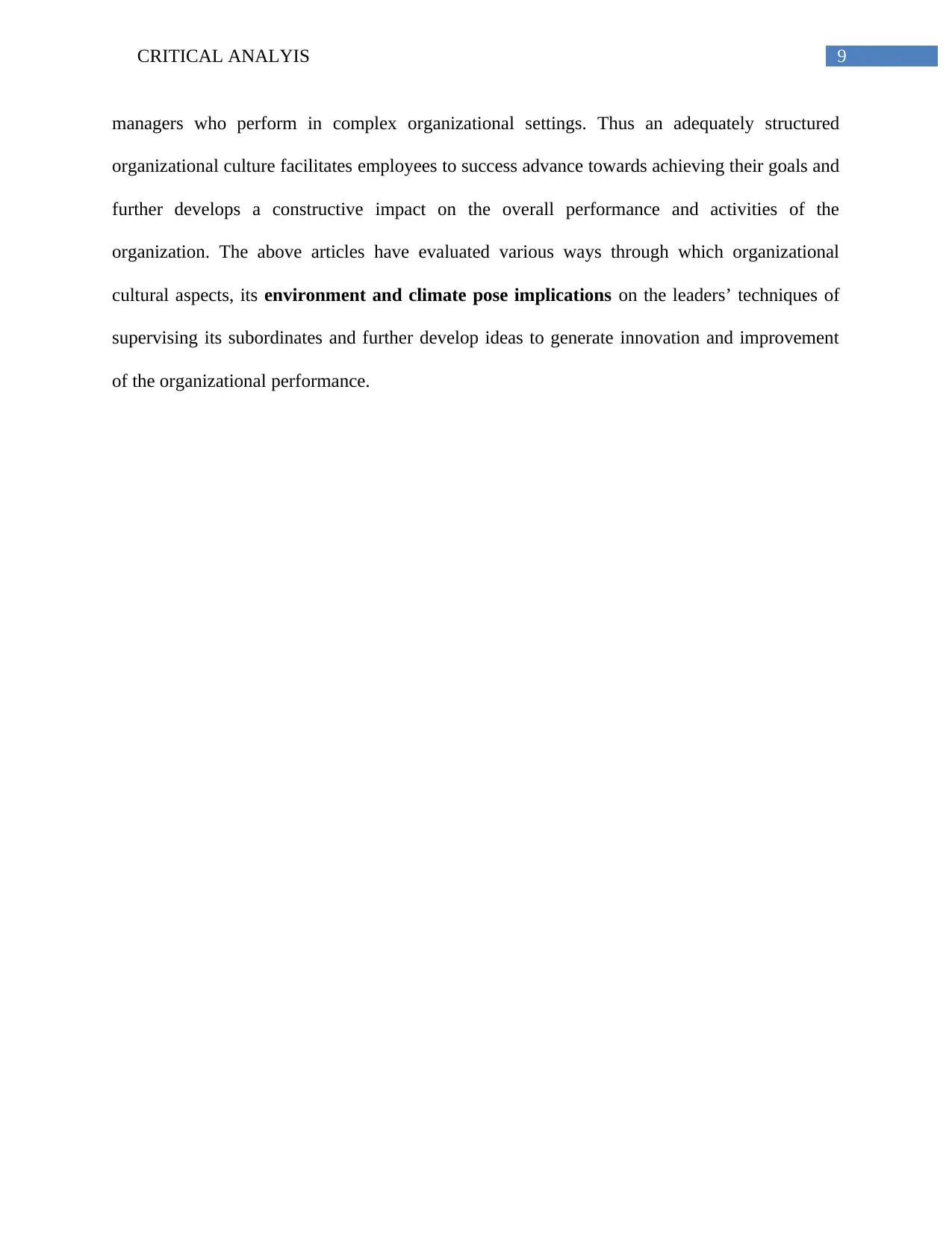
9CRITICAL ANALYIS
managers who perform in complex organizational settings. Thus an adequately structured
organizational culture facilitates employees to success advance towards achieving their goals and
further develops a constructive impact on the overall performance and activities of the
organization. The above articles have evaluated various ways through which organizational
cultural aspects, its environment and climate pose implications on the leaders’ techniques of
supervising its subordinates and further develop ideas to generate innovation and improvement
of the organizational performance.
managers who perform in complex organizational settings. Thus an adequately structured
organizational culture facilitates employees to success advance towards achieving their goals and
further develops a constructive impact on the overall performance and activities of the
organization. The above articles have evaluated various ways through which organizational
cultural aspects, its environment and climate pose implications on the leaders’ techniques of
supervising its subordinates and further develop ideas to generate innovation and improvement
of the organizational performance.
Paraphrase This Document
Need a fresh take? Get an instant paraphrase of this document with our AI Paraphraser
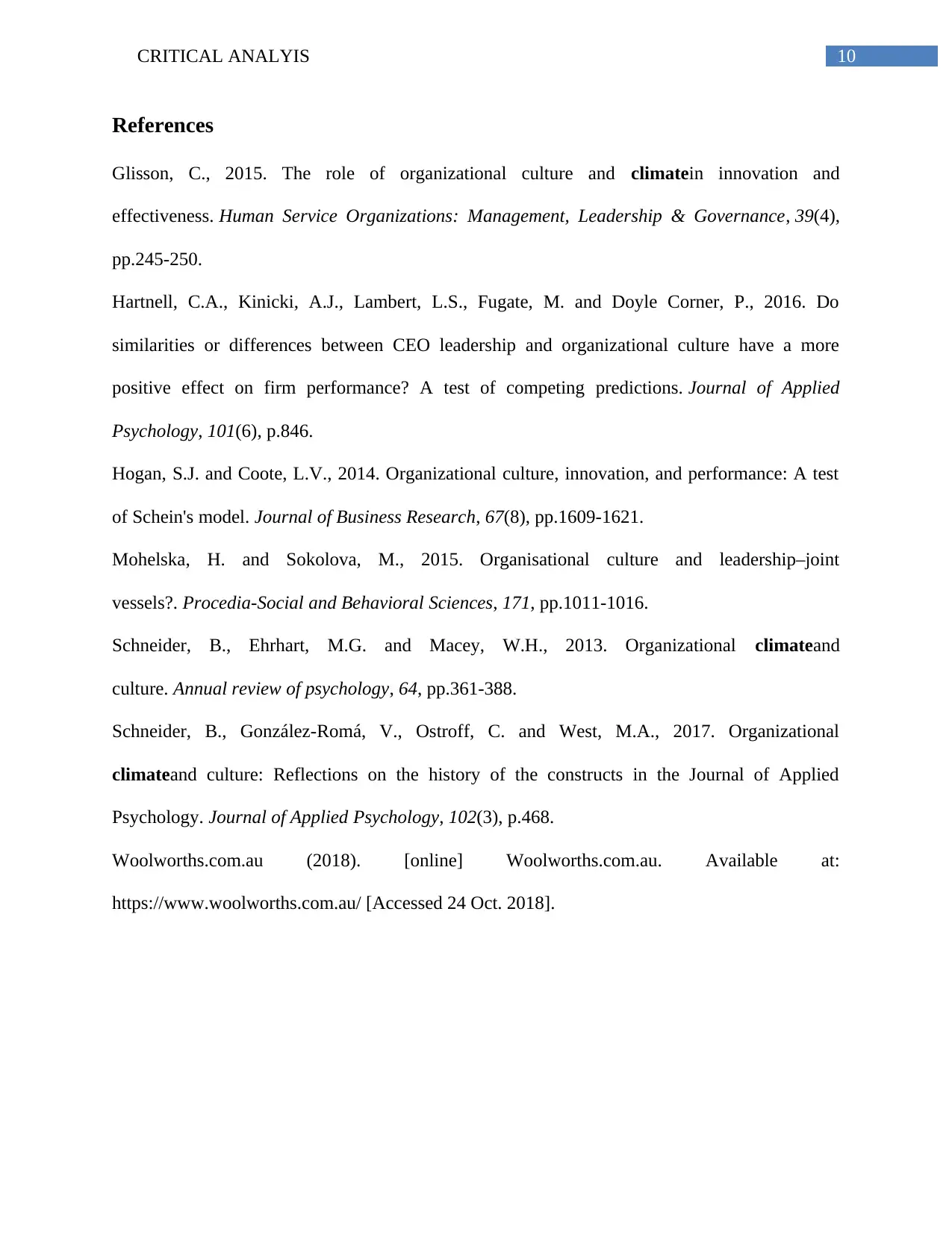
10CRITICAL ANALYIS
References
Glisson, C., 2015. The role of organizational culture and climatein innovation and
effectiveness. Human Service Organizations: Management, Leadership & Governance, 39(4),
pp.245-250.
Hartnell, C.A., Kinicki, A.J., Lambert, L.S., Fugate, M. and Doyle Corner, P., 2016. Do
similarities or differences between CEO leadership and organizational culture have a more
positive effect on firm performance? A test of competing predictions. Journal of Applied
Psychology, 101(6), p.846.
Hogan, S.J. and Coote, L.V., 2014. Organizational culture, innovation, and performance: A test
of Schein's model. Journal of Business Research, 67(8), pp.1609-1621.
Mohelska, H. and Sokolova, M., 2015. Organisational culture and leadership–joint
vessels?. Procedia-Social and Behavioral Sciences, 171, pp.1011-1016.
Schneider, B., Ehrhart, M.G. and Macey, W.H., 2013. Organizational climateand
culture. Annual review of psychology, 64, pp.361-388.
Schneider, B., González-Romá, V., Ostroff, C. and West, M.A., 2017. Organizational
climateand culture: Reflections on the history of the constructs in the Journal of Applied
Psychology. Journal of Applied Psychology, 102(3), p.468.
Woolworths.com.au (2018). [online] Woolworths.com.au. Available at:
https://www.woolworths.com.au/ [Accessed 24 Oct. 2018].
References
Glisson, C., 2015. The role of organizational culture and climatein innovation and
effectiveness. Human Service Organizations: Management, Leadership & Governance, 39(4),
pp.245-250.
Hartnell, C.A., Kinicki, A.J., Lambert, L.S., Fugate, M. and Doyle Corner, P., 2016. Do
similarities or differences between CEO leadership and organizational culture have a more
positive effect on firm performance? A test of competing predictions. Journal of Applied
Psychology, 101(6), p.846.
Hogan, S.J. and Coote, L.V., 2014. Organizational culture, innovation, and performance: A test
of Schein's model. Journal of Business Research, 67(8), pp.1609-1621.
Mohelska, H. and Sokolova, M., 2015. Organisational culture and leadership–joint
vessels?. Procedia-Social and Behavioral Sciences, 171, pp.1011-1016.
Schneider, B., Ehrhart, M.G. and Macey, W.H., 2013. Organizational climateand
culture. Annual review of psychology, 64, pp.361-388.
Schneider, B., González-Romá, V., Ostroff, C. and West, M.A., 2017. Organizational
climateand culture: Reflections on the history of the constructs in the Journal of Applied
Psychology. Journal of Applied Psychology, 102(3), p.468.
Woolworths.com.au (2018). [online] Woolworths.com.au. Available at:
https://www.woolworths.com.au/ [Accessed 24 Oct. 2018].
1 out of 11
Related Documents
Your All-in-One AI-Powered Toolkit for Academic Success.
+13062052269
info@desklib.com
Available 24*7 on WhatsApp / Email
![[object Object]](/_next/static/media/star-bottom.7253800d.svg)
Unlock your academic potential
Copyright © 2020–2025 A2Z Services. All Rights Reserved. Developed and managed by ZUCOL.




